FORMAL FLAG-RAISING OVER BATTERED ISLAND
Iwo Jima, Volcano Islands · March 14, 1945
On this date in 1945 the U.S. flag was raised over the 8.1‑sq‑mile/21‑sq‑km island of Iwo Jima in a formal flag-raising ceremony. The Battle of Iwo Jima (February 19 to March 26, 1945)—a battle for the isolated and barren Japanese-held island lying some 760 miles/1,223 km southeast of Tokyo—was the most bitterly contested of the war. Iwo Jima’s capture was a prelude to the battle for Okinawa, 340 miles/547 km closer to the Japanese Home Islands.
Japanese Army and Navy troops had burrowed deep into the volcanic rock, creating a defensive stronghold of well-concealed tunnels, bunkers, and machine-gun nests intended to inflict maximum casualties on U.S. forces and delay their progress toward their homeland. Each side inflicted enormous carnage on the other, partly because the barren terrain offered little cover, and partly because the key weapons for clearing out the thousands of Japanese positions were hand grenades, handheld flamethrowers, and “Ronson” or “Zippo” tanks that shot flaming liquid on targets almost 500 ft/152 m away.
Over 22,000 Japanese defenders died or committed suicide during the 36‑day campaign, which began on February 19 when landing craft unloaded 30,000 men from the Third, Fourth, and Fifth Marine Divisions (the first of 70,000), along with amphibious vehicles and equipment. Marines and sailors suffered over 6,700 killed out of some 26,500 casualties. Mt. Suribachi, the defining geographical landmark on the island and the site of the flag-raising made famous by Joe Rosenthal’s iconic photograph, was captured on February 23, but resistance continued at the north end of the island for three more weeks.
Capturing Iwo Jima, which lay midway between the Mariana Islands and Japan, had been motivated by the desire to fly long-range P‑51 Mustang fighters from the island to escort B‑29 bombers from their Mariana bases in daylight raids on Japan. That proved unnecessary when U.S. Army Air Forces resorted to low-altitude (under 10,000 ft/3,048 m) night aerial attacks that met no significant Japanese resistance. The island served as an emergency landing strip for American bombers for the rest of the war. Some 2,400 emergency stops were made over the next five months. Most of the landings were precautionary, but if 10 percent of the crews were saved, that represented about 2,600 airmen.
Battle of Iwo Jima, February 19 to March 26, 1945
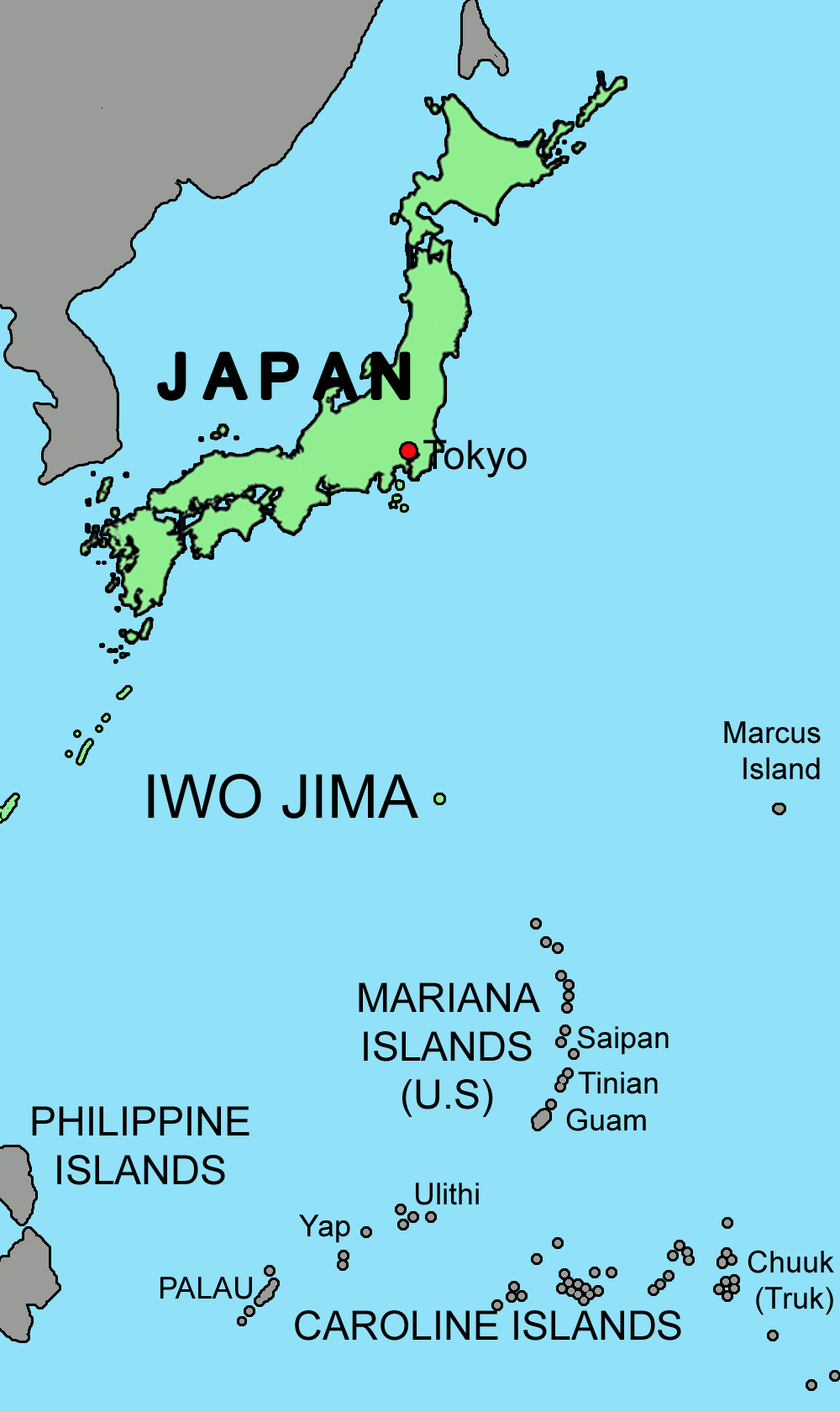 |
Above: Location of the pork-chop-shaped island of Iwo Jima in relation to Tokyo (760 miles/1,223 km due north) and the Mariana Islands (Saipan, 650 miles/1,046 km to the southeast). Iwo Jima was a Japanese citadel protecting the homeland. Japanese aircraft from Iwo Jima were able to bomb U.S. B‑29 bases in the Marianas, and radio operators on Iwo Jima were able to send advance warning to the Japanese Home Islands every time B‑29s passed north overhead.
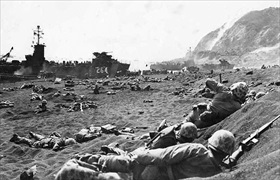 | 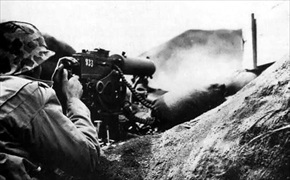 |
Left: Members of the 1st Battalion 23rd Marines burrow in the black volcanic sand on an Iwo Jima beach while their fellow Marines unload supplies and equipment from landing craft under a rain of artillery fire from Japanese positions in the background.
![]()
Right: A Marine fires his Browning M1917 machine gun at a Japanese position. Marines encountered intense artillery fire on Iwo Jima. Japanese troops under their ingenious and courageous commander, Gen. Tadamichi Kuribayashi, were responsible for the deaths of a third of all U.S. Marines killed during the entire four-year Pacific conflict. Twenty-seven Medals of Honor were awarded to Marines and sailors, many posthumously, more than were awarded for any other single operation during the war.
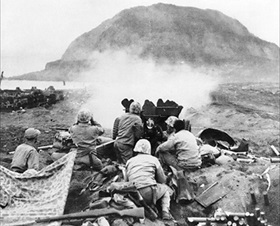 | 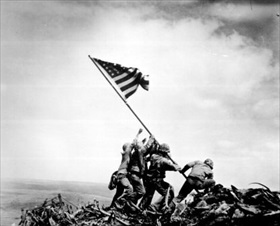 |
Left: A U.S. 1.5‑in/37‑mm gun fires against Japanese cave positions in the north face of 556‑ft‑tall/169‑m-tall Mt. Suribachi, an extinct volcano. These light but extremely accurate weapons did some of their best work in the southern part of the island. Over 35 days approximately 28,000 combatants died, including 6,821 Americans and nearly 22,000 Japanese by fighting or ritual suicide, making Iwo Jima one of the costliest battles of World War II. Only 216 Japanese defenders were captured during the cataclysmic battle.
![]()
Right: Joe Rosenthal’s Pulitzer Prize-winning image depicts five Marines and one sailor raising the Stars and Stripes over Mt. Suribachi five days into the Battle of Iwo Jima. Three of the flag-raisers died at Bloody Gorge on the north side on the island, where the worst of the fighting took place. Three flag-raisers—Marine privates Rene Gagnon and Ira Hayes and Pharmacy Mate Second Class John Bradley—survived the horrific combat and participated in a war bonds tour in the States that featured reenactments of the flag raising.
Contemporary Color Documentary from U.S. Government Office of War Information: “To the Shores of Iwo Jima”
![]()

 History buffs, there is good news! The Daily Chronicles of World War II is now available as an ebook for $4.99 on Amazon.com. Containing a year’s worth of dated entries from this website, the ebook brings the story of this tumultuous era to life in a compelling, authoritative, and succinct manner. Featuring inventive navigation aids, the ebook enables readers to instantly move forward or backward by month and date to different dated entries. Simple and elegant! Click
History buffs, there is good news! The Daily Chronicles of World War II is now available as an ebook for $4.99 on Amazon.com. Containing a year’s worth of dated entries from this website, the ebook brings the story of this tumultuous era to life in a compelling, authoritative, and succinct manner. Featuring inventive navigation aids, the ebook enables readers to instantly move forward or backward by month and date to different dated entries. Simple and elegant! Click 











